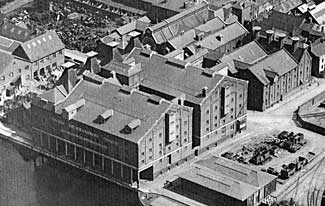 No
1 Malthouse No
1 Malthouse
The Downing family
already had malthouses around the West Midlands, and the new site
at Gloucester was no doubt chosen because of ready access to imported
barley. The original building on the east side of Merchants Rd (to
right of photo) had a basement with a cistern capable of steeping
100 quarters of grain, three working floors on which the grain was
allowed to germinate and four kilns used to complete the production
of malt. Direct railway communication was provided by a siding from
the Midland Railway running along Merchants Rd.
No 2 Malthouse
The first
malthouse was evidently successful, and a second was built to the
north of the first in 1895 (to left of photo above). It had a basement
working floor with a steeping tank, two more working floors and
two store floors. The floor levels were the same as in the first
malthouse, and the gap between the buildings was bridged at two
levels. A range at the north end contained a large malt kiln heated
by four fires and a smaller barley drying kiln heated by two fires.
 Nos 3 & 4 Malthouses Nos 3 & 4 Malthouses
A further expansion took place in
1901, when two more large malthouses were built between Merchants
Rd and Bakers Quay with the upper floors on the west side supported
on pillars over the quay (photo right). Each malthouse had a basement
and four floors with a range of kilns at the north end. A bridge
over Merchants Rd linked the new malthouses to the earlier ones.
Modernisation
In the
early 1950s, a major programme of modifications was carried out.
Most of the original No 1 malthouse was demolished and replaced
by a concrete building containing silos. The associated kiln to
the east was reused to house a barley dryer. The ground floors of
Nos 3 & 4 malthouses, originally used for storing malt in garners
prior to dispatch, were converted into additional working floors,
and the malt was stored in the new silos. The working floors in
Nos 3 & 4 malthouses were provided with forced-draught air cooling
to remove the heat generated by germination - previously, the only
means of temperature control was by adjusting wooden shutters in
the window openings, and this was not sufficient to allow malt production
to continue during the summer months. In the 1970s, the site began
trading under the name Associated British Maltsters, a group that
the Downing's business had joined back in 1931.
Closure
Although the
modernisation programme helped the business, the traditional method
of malt making in use was very labour intensive. Following the installation
of modern plant at other malthouses around the country, the business
at Gloucester could no longer compete, and it closed down circa
1980. The buildings were later used by West Midlands Farmers for
grain storage.
Sources
Glos Arch GBR
L20/1875/4, D7942/415; D2460/4/7/4/22 to 34; Glo Jnl 24 Mar
1877; dates on buildings. Photos by kind permission of Gloucestershire
Archives D7942/491. |